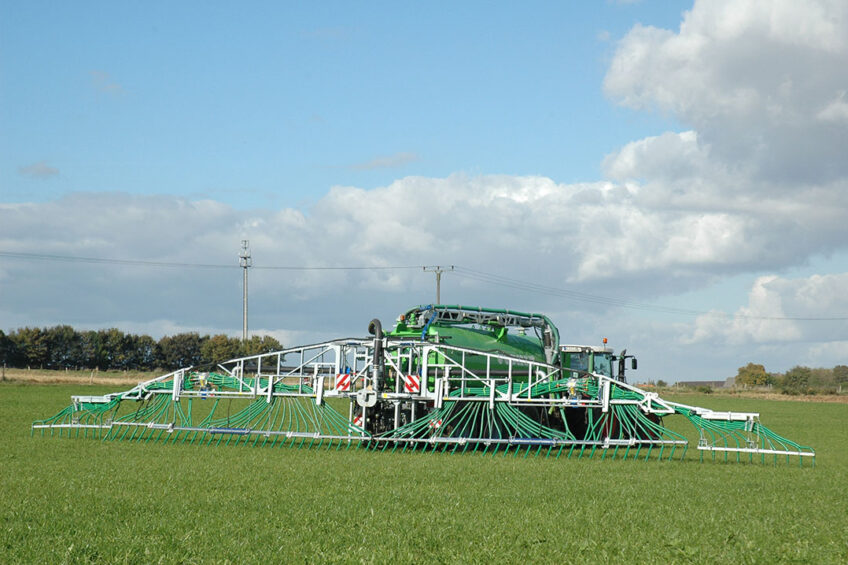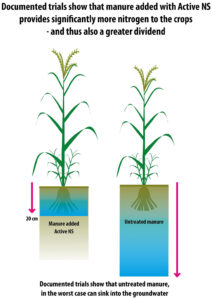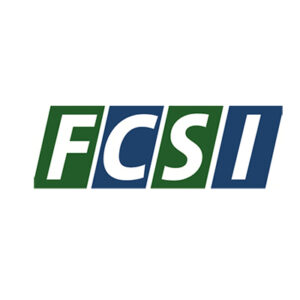Saving artificial fertiliser while reducing nitrate losses

Use of the Active NS additive in manure slurry can help improve nitrogen efficiency at dairy farms. Reducing the need for artificial fertiliser nitrogen by 20% without affecting the yield. This was the result of a trial by Groeikracht Zuid in Steenbergen, the Netherlands.
The 2019 trial comprised a section of a seven-year-old grass meadow, on a river clay soil, being divided into six strips of 11.76 metres wide. Strips 1 and 4 were fertilised as standard, using manure slurry and liquid artificial fertiliser. Strips 2 and 5 were fertilised as standard, using manure slurry and liquid artificial fertiliser, whereby the Active NS was added to the manure slurry. Strips 3 and 6 were fertilised as for 2 and 5, but with 20%less nitrogen and sulphur from artificial fertiliser. The manure slurry in question was derived from a single barn, in which the dairy cattle all received the same feed ration. The manure storage area under the barn was divided into two compartments, and Active NS added to one of them. The manure slurry was applied prior to the first, second and fourth cuts.
‘Less nitrogen losses’
Examination of manure samples showed the volume of nitrogen in the treated manure to be higher.
Upon starting the trial, manure samples from the barn compartment to which Active NS was to be added, already contained more nitrogen. This difference increased even further until April, after which it decreased again (Table 1). According to FCSI, producer of Active NS, the higher level of nitrogen is due to reduced evaporation of the nitrogen following addition of Active NS, leaving more in the manure. Evaporation of other gases from the manure is also limited thanks to Active NS, according to FCSI.
Table 1- volume of N-total and ammonia nitrogen (kilograms per ton of manure slurry) during the trial.

Same yield using less artificial fertiliser
In order to determine the yield, five sections of grass from each strip, measuring 0.25 square metres, were randomly manually harvested, weighed and sampled by Eurofins, prior to the standard mowing process. The meadow was mowed six times over the year. A total of 11,283 kilograms of dry matter and 10.663 KVEM (net energy) were harvested per hectare. This translated into 303 kilograms of nitrogen per hectare.
Over the season, no significant differences were measured, neither in the yield nor quality of the fresh grass. However, the strips whereby manure slurry with Active NS and 20% less artificial fertiliser nitrogen was used, produced the same yield and quality as the reference strips. It can therefore be concluded that Active NS can save 20% of artificial fertiliser nitrogen, based on a single field trial at a single location.
fertiliser nitrogen was used, produced the same yield and quality as the reference strips. It can therefore be concluded that Active NS can save 20% of artificial fertiliser nitrogen, based on a single field trial at a single location.
Reduced leaching to deeper layers
In February and in November, soil samples were taken at four different depths over the entire trial object, for examination purposes. The analysis showed the greatest variances to be found in the deeper soil layers, at a depth of 30 to 90cm. In autumn, there was less N-total and less nitrate nitrogen found in the strips in which Active NS was applied, which would indicate reduced leaching and/or more efficient absorption.
Conclusion
The use of Active NS can contribute to greater nitrogen efficiency in grassland. The efficiency of manure slurry would seem to be improved, which will give savings in artificial fertiliser and reduced losses of nitrate due to leaching. This is very much in keeping with the current targets faced by the agricultural sector.
Author: Gerben Hofman
Published first on Melkveebedrijf.nl


